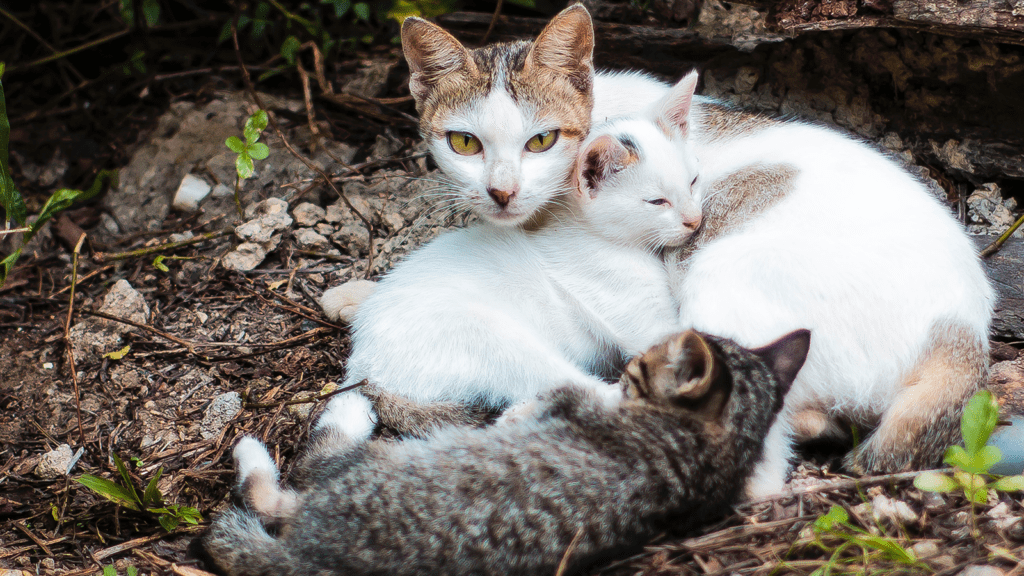
Cat colonies and community cats
Outdoor cat colonies can contain anywhere from two stray cats to over thirty. Stray cats depend on humans for survival and often hover close to human populations, even when they’re feral. The best ways to help outdoor cat colonies are to donate either time or money to local organizations, participate in TNR programs, or become a colony caretaker for the strays in your neighborhood.
In this article, we’ll talk all about cat colonies, how rapidly they grow, how large their territory ranges, and how you can get involved to help the cats in your area.
What is a group of cats called?
A group of cats is known as a Clowder. You need three or more cats to have a clowder of them! If you have a group of kittens born to the same mother, they’re known as a litter. A group of cats living as strays outdoors is called a colony. There are actually many more names for a group of cats, including a Destruction and a Glaring.
What is a cat colony?
A cat colony is a group of stray cats living in the same territory outdoors. They can live anywhere from rural farmland to city streets but are typically located close to humans due to their dependency on us.
It’s important that a cat colony has a human caretaker. This lengthens the lifespan of the cats and controls the population. When outdoor cats have a caretaker, we usually call them community cats!
A good caretaker will ensure all cats receive veterinary care, including a spay or neuter surgery, vaccinations, and parasite prevention medication. They also typically feed the cats and help provide safe shelters.
How many cats are in a colony?
Cat colonies can begin with just two cats, but they usually multiply. Unless all of the cats are neutered or spayed, they’ll continue having kittens.
Female cats can birth up to three litters each year. An average litter has 3-5 kittens, though some are much larger. One mother cat can produce over fifteen kittens each year—potentially many more if her litters are large.
About half of these kittens will be female, and they’ll go on to have their own litters once they reach four months of age.
By the time a mother cat births her third litter of five kittens each, the females from the first two litters—approximately five of them—will birth their own first or second litters.
This adds over 35 more kittens to our count, all stemming from that first female cat within one year. This is how quickly a colony of two could turn into a colony of over 50 cats!
Population control is our responsibility as humans because we’re the ones who domesticated cats and brought them into so many environments where they now live as invasive species.
We promote TNR, or trap, neuter, return, as an ethical way to control stray and feral cat populations.
How large is a feral cat’s territory?
A feral cat’s territory can exceed 1300 acres, or about half a mile (source). Unaltered cats have more tendency to roam, as do those without a human caretaker to provide food. Unneutered male cats with no caretaker have the largest range.
This is a far distance for a cat to travel, especially when you remember how much of their lives are spent sleeping! It’s also hazardous for the cat, as the study linked above shows them crossing roads and dying of disease.
Do feral cats leave the colony?
The closest members of the colony are the females. They will share food and even nurse each other’s kittens. Female cats interact within the colony regularly.
Unneutered male cats have more tendency to wander and aren’t as interactive—at least, not until mating time rolls around.
Cats don’t tend to leave their territory but instead linger near human dwellings as they get hungry. Remember, they’re domesticated animals—they rely on us for food, even if it’s via digging through our trash or eating the mice our garbage attracts.
Male cats may wander away from the colony but typically remain in their territory and return as they please.
How can I help a feral cat colony?
There are many ways to help feral cat colonies. Here are some to consider:
- Contact your local organizations. Reach out to TNR groups and nearby cat rescues and see if they need help! These people are already doing the work. We must band together in the world of cat advocacy to encourage humane practices and adoptions. Many people dream of starting their own rescue—but often, there are already groups putting in the work who need your help.
- Participate in TNR (Trap, Neuter, Return). TNR begins by catching a cat in a humane live trap. They’re brought to a veterinarian to be neutered or spayed and ear-tipped so that the community knows they’re altered. Then, they’re returned to their territory outdoors.
Another version of TNR, known as TNRM, includes monitoring the cats after altering them. This is where a caretaker comes into play. - Become a caretaker for your local cat colony. Caretakers provide food and veterinary care for community cats. This may seem expensive, but often, you don’t have to go it on your own financially. This is where being an active part of your community is important—rescues may be able to help with costs or even provide transport if you’re unable. There are also many low-cost spay and neuter programs available.
- Leave shelters out of it. Animal shelters are excellent resources, but they aren’t equipped to handle feral cats. Never bring a feral into a shelter—there’s a high chance it may be euthanized.
Most feral cats are best cared for outdoors or brought indoors by someone patient and willing to tame them. - Taming is slow and ineffective. We applaud anyone who brings in a cat and has the patience to work with ferals! It’s definitely possible to foster a feral cat into a friendly housecat, and it happens all the time. However, it takes a long time, dedication, and a lot of resources, which is why you seldom see rescue groups attempting it. We aren’t saying it isn’t a wonderful thing for the single feral helped, just that it does less for the cat population as a whole. If your goal is to help as many cats as possible, rehabbing ferals one at a time isn’t very effective.
Some people also argue that trying to rehab a feral is cruel since they’re so afraid of human interaction. This may depend on many factors, like the cat’s age, health, and more. We urge you to do your research and make a cat-by-cat decision.



